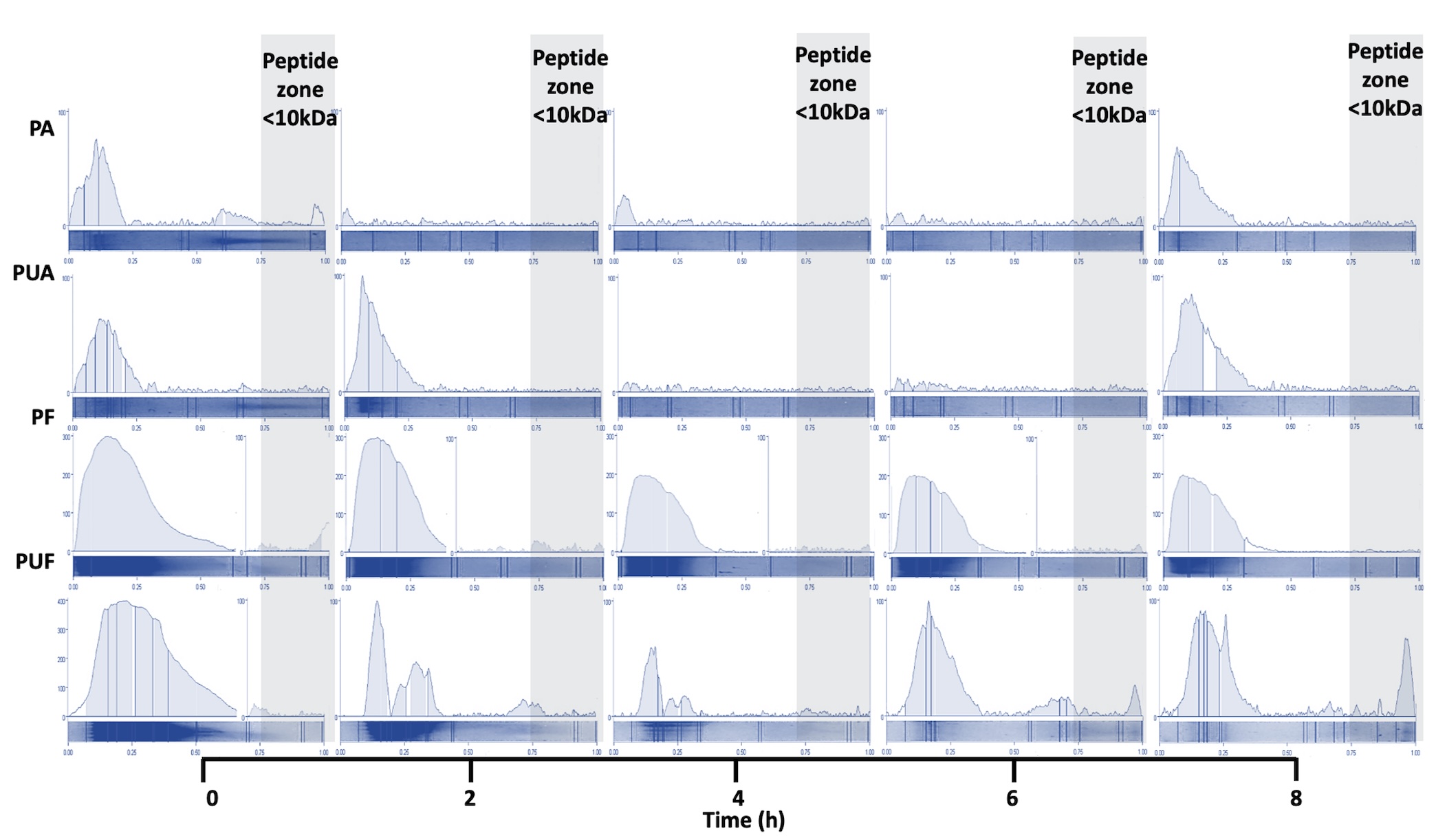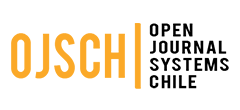ANTIOXIDANT CAPACITY OF PEPTIDES DERIVED FROM THE ENZYMATIC HYDROLYSIS OF RAINBOW TROUT (Oncorhynchus mykiss) SKIN: EFFECT OF PASTEURIZATION AND ULTRASONICATION PRE-TREATMENT
- Enzymatic hydrolysis,
- Antioxidant activity,
- Skin trout proteins,
- Bioactive peptides,
- Pre-treatment
Copyright (c) 2024 SChQ

This work is licensed under a Creative Commons Attribution-NonCommercial-ShareAlike 4.0 International License.
Abstract
Rainbow trout skin and viscera are considered non-commercial by-products with high protein content. This research aimed to determine the incidence of pasteurization and ultrasonication during the obtaining of antioxidant peptides by the hydrolysis of trout skin proteins with Alcalase and Flavourzyme. Solutions of freeze-dried skin were prepared (20 % w/v), and two pretreatments were performed: pasteurization (90 ºC for 10 min) and a combination of pasteurization and ultrasonication (40 kHz x 15 min). Hydrolysis was for 8 hours with Alcalase (pH 9, 55°C) and Flavourzyme (pH: 7, 50°C) sampling every 2 hours. The degree of hydrolysis was determined by TNBS and SDS-PAGE. Antioxidant activity was determined by DPPH and FRAP. The ultrasonication does not affect the release of peptides with antioxidant capacity. In addition, greater antioxidant capacity was determined in hydrolysates with Flavourzyme. Results would allow establishing the conditions for the optimized obtaining of this type of peptide fractions.

References
- A. P. Dysin, Y. S. Shcherbakov, O. A. Nikolaeva, V. P. Terletskii, V. I. Tyshchenko, N. V. Dementieva, Salmonidae Genome: Features, Evolutionary and Phylogenetic Characteristics, Genes, 13(12), 2221, (2022).
- B. de la Fuente, N. Pallarés, H. Berrada, F. J. Barba, Salmon (Salmo salar) Side Streams as a Bioresource to Obtain Potential Antioxidant Peptides after Applying Pressurized Liquid Extraction (PLE), Mar. Drugs, 19(6), 323, (2021) doi: 10.3390/MD19060323.
- S. A. Cunha, M. E. Pintado, Bioactive peptides derived from marine sources: Biological and functional properties, Trends Food Sci. Technol., 119, 348–370, (2022), doi: 10.1016/J.TIFS.2021.08.017.
- S. K. Ulug, F. Jahandideh, J. Wu, Novel technologies for the production of bioactive peptides, Trends Food Sci. Technol., 108, 27–39, (2021), doi: 10.1016/j.tifs.2020.12.002.
- M. A. Murtaza, S. Irfan, I. Hafiz, M. Ranjha1, A. Rahaman, M. S. Murtaza, S. Ibrahim, S. Siddiqui, Conventional and Novel Technologies in the Production of Dairy Bioactive Peptides, Front. Nutr., 9, (2022), doi: 10.3389/FNUT.2022.780151.
- C. M. Guerra-Almonacid, J. G. Torruco-Uco, W. Murillo-Arango, J. J. Méndez-Arteaga, J. Rodríguez-Miranda, Effect of ultrasound pretreatment on the antioxidant capacity and antihypertensive activity of bioactive peptides obtained from the protein hydrolysates of Erythrina edulis, Emir J Food Agric, 31(4), 288–296, (2019), doi: 10.9755/EJFA.2019.V31.I4.1938.
- S. Ketnawa, A. M. Liceaga, Effect of Microwave Treatments on Antioxidant Activity and Antigenicity of Fish Frame Protein Hydrolysates, Food Bioproc Tech, 10(3), 582–591, (2017), doi: 10.1007/S11947-016-1841-8/METRICS.
- E. Zielińska, B. Baraniak, M. Karaś, Antioxidant and Anti-Inflammatory Activities of Hydrolysates and Peptide Fractions Obtained by Enzymatic Hydrolysis of Selected Heat-Treated Edible Insects, Nutrients, 9(9), 970, (2017), doi: 10.3390/NU9090970.
- J. Adler-Nissen, Determination of the degree of hydrolysis of food protein hydrolysates by trinitrobenzenesulfonic acid, J Agric Food Chem, 27(6), 1256–1262, (1979), doi: 10.1021/JF60226A042.
- H. Schägger, G. von Jagow, Tricine-sodium dodecyl sulfate-polyacrylamide gel electrophoresis for the separation of proteins in the range from 1 to 100 kDa, Anal Biochem, 166(2), 368–379, (1987), doi: 10.1016/0003-2697(87)90587-2.
- L. G. González-Olivares, J. Jiménez-Guzmán, A. Cruz-Guerrero, G. Rodríguez-Serrano, L. Gómez-Ruiz, M. García-Garibay, Liberación de péptidos bioactivos por bacterias lácticas en leches fermentadas comerciales, Rev Mex Ing Quim, 10(2), 179–188, (2011)
- J. Ramírez-Godínez, J. Jaimez-Ordaz, A. Castañeda-Ovando, J. Añorve-Morga, V. Salazar-Pereda, L. G. González-Olivares, E. Contreras-López., Optimization of Physical Conditions for the Aqueous Extraction of Antioxidant Compounds from Ginger (Zingiber officinale) Applying a Box-Behnken Design, Plant Foods Hum. Nutr., 72(1), (2017), doi: 10.1007/s11130-016-0582-1.
- Y. Chen, J. Jaczynski, Protein Recovery from Rainbow Trout (Oncorhynchus mykiss) Processing Byproducts via Isoelectric Solubilization/Precipitation and Its Gelation Properties As Affected by Functional Additives, J Agric Food Chem, 55(22), 9079–9088, (2007). https://sci-hub.se/https://doi.org/10.1021/jf071992w
- V. G. Tacias-Pascacio, R. Morellon-Sterling, E. H. Siar, O. Tavano, Á. Berenguer-Murcia, R. Fernandez-Lafuente, Use of Alcalase in the production of bioactive peptides: A review, Int J Biol Macromol, 165, 2143–2196, (2020), 10.1016/J.IJBIOMAC.2020.10.060.
- S. Sun, Y. Gao, J. Chen, R. Liu, Identification and release kinetics of peptides from tilapia skin collagen during alcalase hydrolysis, Food Chem, 378, 132089, (2022), doi: 10.1016/J.FOODCHEM.2022.132089.
- Y. Xu, M. Galanopoulos, E. Sismour, S. Ren, Z. Mersha, P. Lynch, A. Almutaimi, Effect of enzymatic hydrolysis using endo- and exo-proteases on secondary structure, functional, and antioxidant properties of chickpea protein hydrolysates, Journal of Food Measurement and Characterization, 14(1), 343–352, (2020), doi: 10.1007/S11694-019-00296-0/METRICS.
- N.T. Hou, B.H. Chen, Extraction, Purification and Characterization of Collagen Peptide Prepared from Skin Hydrolysate of Sturgeon Fish, Food Qual. Saf, (2023), doi: 10.1093/FQSAFE/FYAD033.
- S. Karnjanapratum, S. Benjakul, Asian bullfrog (Rana tigerina) skin gelatin extracted by ultrasound-assisted process: Characteristics and in-vitro cytotoxicity, Int J Biol Macromol, 148, 391–400, (2020), doi: 10.1016/J.IJBIOMAC.2020.01.150.
- S. Indriani, T. Sae-leaw, S. Benjakul, T. Hong Quan, S. Karnjanapratum, S. Nalinanon, Impact of different ultrasound-assisted processes for preparation of collagen hydrolysates from Asian bullfrog skin on characteristics and antioxidative properties, Ultrason Sonochem, 89, 106163, (2022), doi: 10.1016/J.ULTSONCH.2022.106163.
- S. Tabarestani, Y. Maghsoudlou, A. Motamedzadegan, S. Mahoonak, H. Rostamzad, Study on some properties of acid-soluble collagens isolated from fish skin and bones of rainbow trout (Onchorhynchus mykiss), Int Food Res J, 19, 251–257, (2012).
- J. K. Lee, S. Kang, Y. J. Kim, M. J. Kim, M. Heu, B. Choi, J. Kim, Comparison of collagen characteristics of sea- and freshwater-rainbow trout skin, Food Sci Biotechnol, 25, 131, (2016), doi: 10.1007/S10068-016-0020-Z.
- M. Blanco, J. A. Vázquez, R. I. Pérez-Martín, C. G. Sotelo, Hydrolysates of Fish Skin Collagen: An Opportunity for Valorizing Fish Industry Byproducts, Marine Drugs, 15(5), 131, (2017), doi: 10.3390/MD15050131.
- S. Gorgieva, V. Kokol, S. Gorgieva, V. Kokol, Collagen- vs. Gelatine-Based Biomaterials and Their Biocompatibility: Review and Perspectives, Biomaterials Applications for Nanomedicine, (2011), doi: 10.5772/24118.
- A. V. Le Gouic, P. A. Harnedy, R. J. FitzGerald, Bioactive Peptides From Fish Protein By-Products, Bioactive Molecules in Food, JM. Mérillon and K. Ramawat, Springer, 2018.
- Z. Yaghoubzadeh, F. Peyravii Ghadikolaii, H. Kaboosi, R. Safari, E. Fattahi, Antioxidant Activity and Anticancer Effect of Bioactive Peptides from Rainbow Trout (Oncorhynchus mykiss) Skin Hydrolysate., Int J Pept Res Ther, 1–8, (2019).
- I. Lassoued, L. Mora, R.Nasri, M. Jridi, F. Toldrá, M.C. Aristoy, A. Barkia, M. Nasri, Characterization and comparative assessment of antioxidant and ACE inhibitory activities of thornback ray gelatin hydrolysates, J Funct Foods, 13, 225–238, (2015), doi: 10.1016/J.JFF.2014.12.042.
- R. Abuine, A. U. Rathnayake, H. G. Byun, Biological activity of peptides purified from fish skin hydrolysates, Fisheries and Aquatic Sciences, 22, 1–14, (2019), doi: 10.1186/S41240-019-0125-4.


